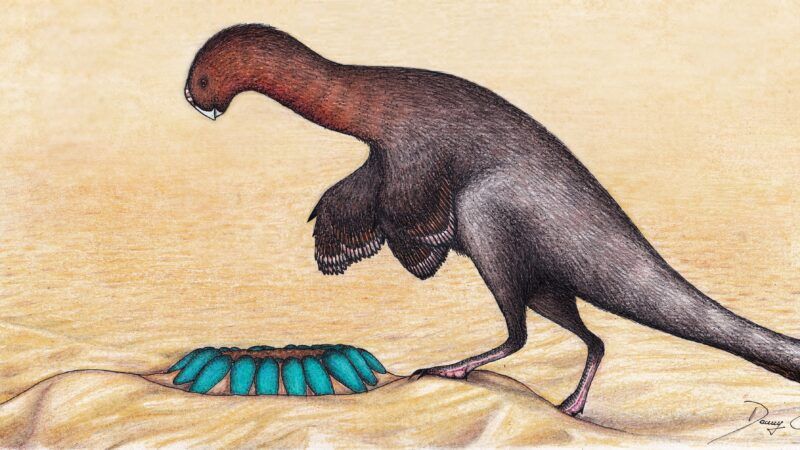The First Colored Eggs Appeared Long Before Easter
The dinosaur ancestors of birds laid blue, brown, and speckled eggs as far back as 150 million years ago.

This Easter, we've hidden a dozen colorful, egg-centric stories across Reason.com. Hop around the site to find them—or click here to see them all in one basket.
The tradition of coloring eggs to celebrate Easter can be traced to the 13th-century Britain, and perhaps even earlier, to early Christian Europe and Mesopotamia. But these were not the first colored eggs. Researchers have recently determined that they likely appeared about 150 million years ago.
The story of that discovery begins just over 100 years ago, when swashbuckling fossil hunter Roy Chapman Andrews first dug up a clutch of dinosaur eggs in intact nests in Mongolia. (Although hailed as the first discovery, two French naturalists in the mid-19th century had actually found dinosaur eggshells earlier, but mistakenly attributed them to giant birds at the time.)
Andrews' privately funded expeditions on behalf of the American Museum of Natural History in New York were financed with help from prominent businessmen, including John Pierpont Morgan and John D. Rockefeller. In 1923, Andrews uncovered an oviraptor nest containing 15 eggs in Mongolia's Djadochta Formation. Given the early stage of paleontology, Andrews and his contemporaries could not know what color (if any) the eggs may have sported before becoming fossilized.
A team of paleontologists associated with the American Museum of Natural History and Yale and Bonn Universities has recently resolved that issue. In 2018, they reported in Nature that the eggs from at least some of the dinosaur ancestors of birds were colored. "As with many other characteristics, this is an attribute that evolved deep within the dinosaur tree and long before the spectacular radiation of modern birds," concluded the authors. Dinosaur and bird egg colors have a single evolutionary origin. Like the eggs of reptiles today, the eggs of dinosaurs not ancestral to birds were white or translucent.
Using a microscopic technique that analyzes the chemical composition of materials by examining how they scatter light, the researchers identified molecules of protoporphyrin and biliverdin in their shells. Dinosaur eggs, like bird eggs today, get their colors and speckles from various combinations of those two molecules. Biliverdin is the source of blue/green and protoporphyrin provides the rusts and browns.

Many of the dinosaur ancestors of birds were relatively small feathered, bipedal predators. These include the Chinese oviraptor Heyuannia huangi, whose eggs were blue/green. Deinonychus antirrhopus eggs found in Montana were also blue/green but speckled brown. Mongolian troodontids' eggs were white decorated with brown speckles or blue/green with speckles. The eggs of a Mongolian enantiornithine, a kind of early bird, were a uniform brown.
Happy Easter to all you egg-dyers who are participating in what is a very long tradition indeed!
Show Comments (8)